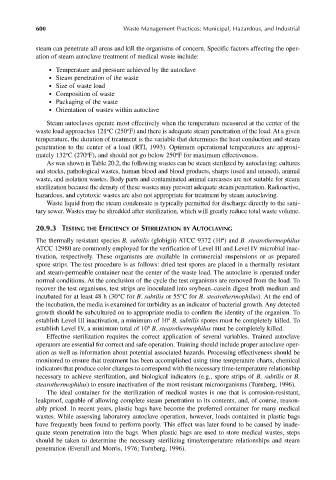Page 629 - Materials Chemistry, Second Edition
P. 629
CAT3525_C20.qxd 1/27/2005 12:54 PM Page 600
600 Waste Management Practices: Municipal, Hazardous, and Industrial
steam can penetrate all areas and kill the organisms of concern. Specific factors affecting the oper-
ation of steam autoclave treatment of medical waste include:
● Temperature and pressure achieved by the autoclave
● Steam penetration of the waste
● Size of waste load
● Composition of waste
● Packaging of the waste
● Orientation of wastes within autoclave
Steam autoclaves operate most effectively when the temperature measured at the center of the
o
o
waste load approaches 121 C (250 F) and there is adequate steam penetration of the load. At a given
temperature, the duration of treatment is the variable that determines the heat conduction and steam
penetration to the center of a load (RTI, 1993). Optimum operational temperatures are approxi-
o
o
o
mately 132 C (270 F), and should not go below 250 F for maximum effectiveness.
As was shown in Table 20.2, the following wastes can be steam sterilized by autoclaving: cultures
and stocks, pathological wastes, human blood and blood products, sharps (used and unused), animal
waste, and isolation wastes. Body parts and contaminated animal carcasses are not suitable for steam
sterilization because the density of these wastes may prevent adequate steam penetration. Radioactive,
hazardous, and cytotoxic wastes are also not appropriate for treatment by steam autoclaving.
Waste liquid from the steam condensate is typically permitted for discharge directly to the sani-
tary sewer. Wastes may be shredded after sterilization, which will greatly reduce total waste volume.
20.9.3 TESTING THE EFFICIENCY OF STERILIZATION BY AUTOCLAVING
4
The thermally resistant species B. subtilis (globigii) ATCC 9372 (10 ) and B. stearothermophilus
ATCC 12980 are commonly employed for the verification of Level III and Level IV microbial inac-
tivation, respectively. These organisms are available in commercial suspensions or as prepared
spore strips. The test procedure is as follows: dried test spores are placed in a thermally resistant
and steam-permeable container near the center of the waste load. The autoclave is operated under
normal conditions. At the conclusion of the cycle the test organisms are removed from the load. To
recover the test organisms, test strips are inoculated into soybean–casein digest broth medium and
incubated for at least 48 h (30°C for B. subtilis or 55°C for B. stearothermophilus). At the end of
the incubation, the media is examined for turbidity as an indicator of bacterial growth. Any detected
growth should be subcultured on to appropriate media to confirm the identity of the organism. To
4
establish Level III inactivation, a minimum of 10 B. subtilis spores must be completely killed. To
6
establish Level IV, a minimum total of 10 B. stearothermophilus must be completely killed.
Effective sterilization requires the correct application of several variables. Trained autoclave
operators are essential for correct and safe operation. Training should include proper autoclave oper-
ation as well as information about potential associated hazards. Processing effectiveness should be
monitored to ensure that treatment has been accomplished using time temperature charts, chemical
indicators that produce color changes to correspond with the necessary time-temperature relationship
necessary to achieve sterilization, and biological indicators (e.g., spore strips of B. subtilis or B.
stearothermophilus) to ensure inactivation of the most resistant microorganisms (Turnberg, 1996).
The ideal container for the sterilization of medical wastes is one that is corrosion-resistant,
leakproof, capable of allowing complete steam penetration to its contents, and, of course, reason-
ably priced. In recent years, plastic bags have become the preferred container for many medical
wastes. While assessing laboratory autoclave operation, however, loads contained in plastic bags
have frequently been found to perform poorly. This effect was later found to be caused by inade-
quate steam penetration into the bags. When plastic bags are used to store medical wastes, steps
should be taken to determine the necessary sterilizing time/temperature relationships and steam
penetration (Everall and Morris, 1976; Turnberg, 1996).

